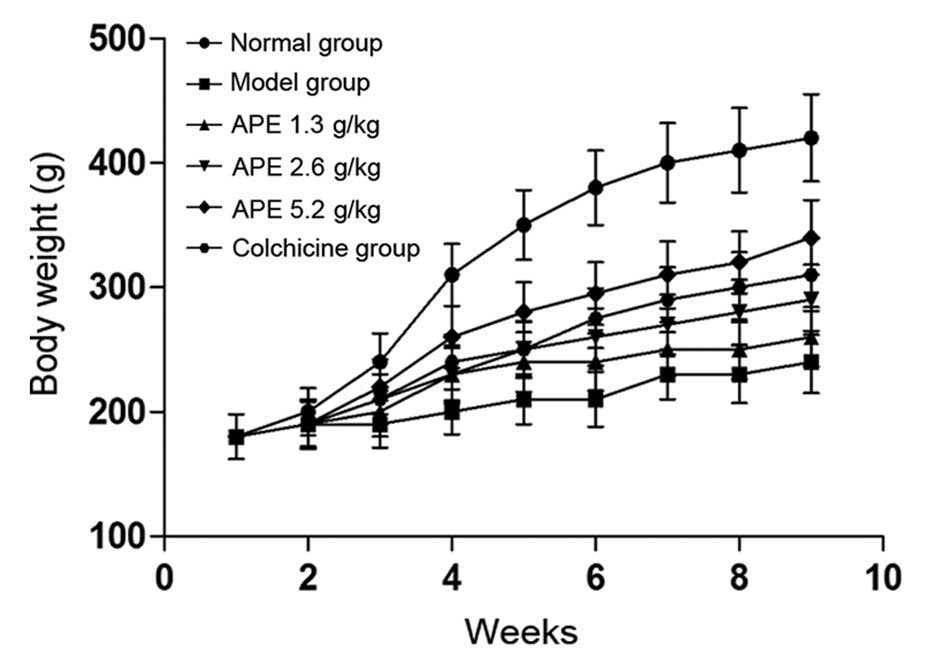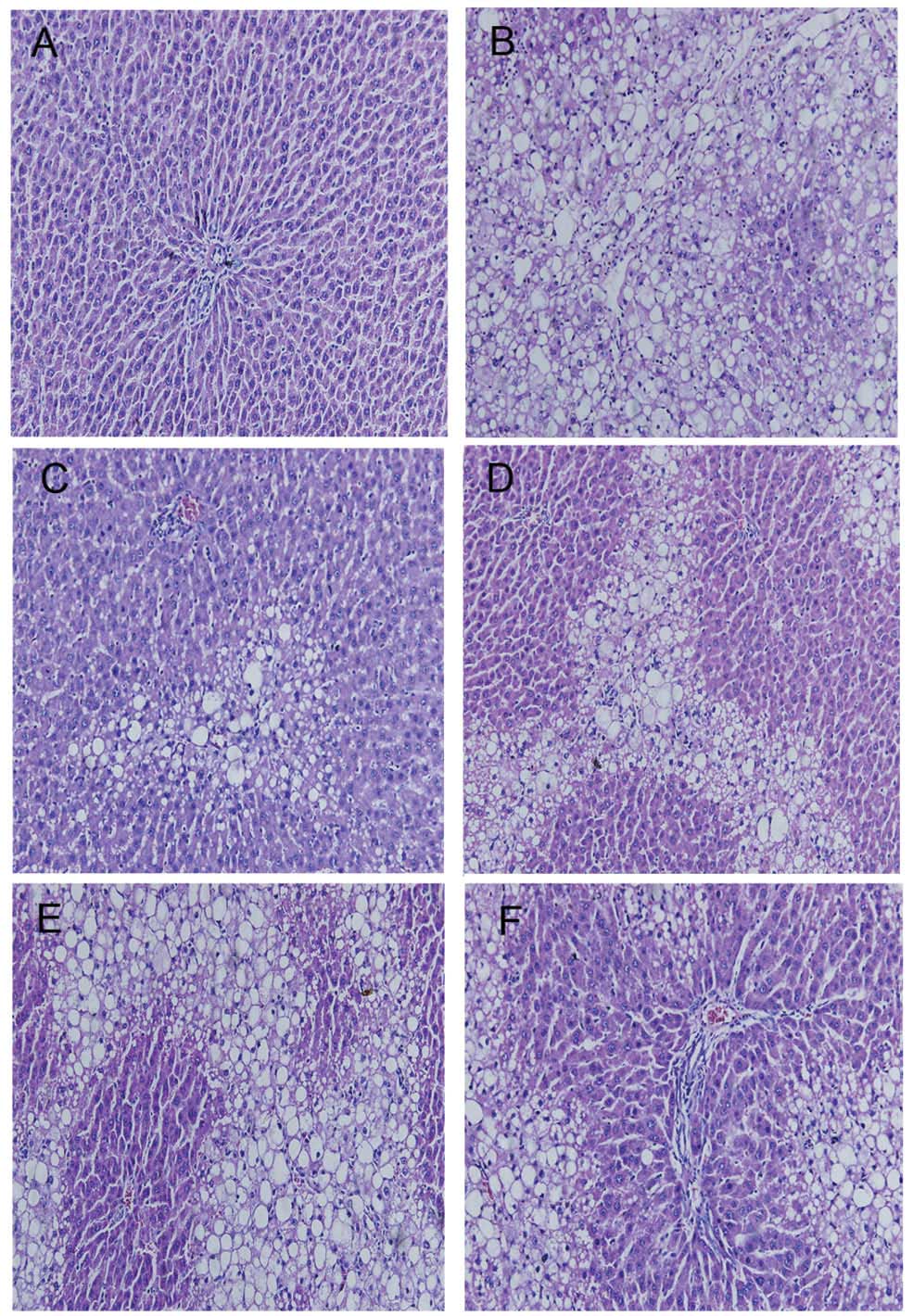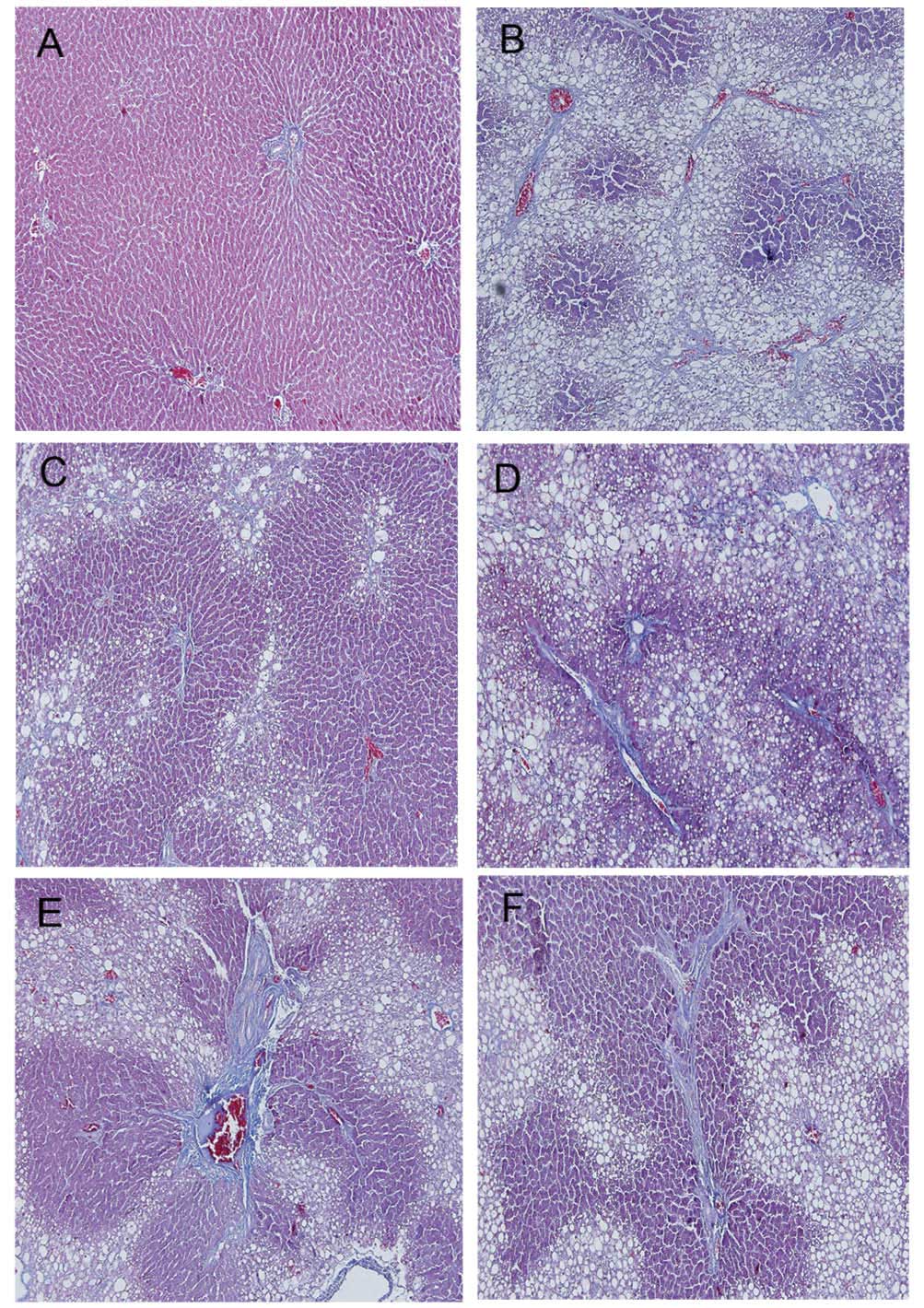|
1
|
Handa P and Kowdley KV: Chemokines: potent
mediators of hepatic inflammation and fibrosis in chronic liver
diseases. Ann Hepatol. 13:152–154. 2013.
|
|
2
|
Puche JE, Saiman Y and Friedman SL:
Hepatic stellate cells and liver fibrosis. Compr Physiol.
3:1473–1492. 2013. View Article : Google Scholar : PubMed/NCBI
|
|
3
|
Mera K, Uto H, Mawatari S, Ido A,
Yoshimine Y, Nosaki T, Oda K, Tabu K, Kumagai K, Tamai T, et al:
Serum levels of apoptosis inhibitor of macrophage are associated
with hepatic fibrosis in patients with chronic hepatitis C. BMC
Gastroenterol. 14:272014. View Article : Google Scholar : PubMed/NCBI
|
|
4
|
Friedman SL: Liver fibrosis in 2012:
convergent pathways that cause hepatic fibrosis in NASH. Nat Rev
Gastroenterol Hepatol. 10:71–72. 2013. View Article : Google Scholar : PubMed/NCBI
|
|
5
|
Bataller R and Brenner DA: Liver fibrosis.
J Clin Invest. 115:209–218. 2005. View
Article : Google Scholar : PubMed/NCBI
|
|
6
|
Tsukada S, Parsons CJ and Rippe RA:
Mechanisms of liver fibrosis. Clin Chim Acta. 364:33–60. 2006.
View Article : Google Scholar
|
|
7
|
Tahashi Y, Matsuzaki K, Date M, Yoshida K,
Furukawa F, Sugano Y, Matsushita M, Himeno Y, Inagaki Y and Inoue
K: Differential regulation of TGF-beta signal in hepatic stellate
cells between acute and chronic rat liver injury. Hepatology.
35:49–61. 2002. View Article : Google Scholar : PubMed/NCBI
|
|
8
|
Gabriel A, Ziólkowski A, Radlowski P,
Tomaszek K and Dziambor A: Hepatocyte steatosis in HCV patients
promotes fibrosis by enhancing TGF-beta liver expression. Hepatol
Res. 38:141–146. 2008.
|
|
9
|
Ray K: Liver: Hepatic stellate cells hold
the key to liver fibrosis. Nat Rev Gastroenterol Hepatol.
11:742014. View Article : Google Scholar
|
|
10
|
Cheng K, Yang N and Mahato RI: TGF-beta1
gene silencing for treating liver fibrosis. Mol Pharm. 6:772–779.
2009. View Article : Google Scholar : PubMed/NCBI
|
|
11
|
Qian H, Shi J, Fan TT, Lv J, Chen SW, Song
CY, Zheng ZW, Xie WF and Chen YX: Sophocarpine attenuates liver
fibrosis by inhibiting the TLR4 signaling pathway in rats. World J
Gastroenterol. 20:1822–1832. 2014. View Article : Google Scholar : PubMed/NCBI
|
|
12
|
Wu BR, Zheng YL, Sang XL, Jin M, Wang WZ,
Zhang QS, Zhao SX and Kong L: Role of the IGF-1/PI3K pathway and
the molecular mechanism of Fuzhenghuayu therapy in a spontaneous
recovery rat model of liver fibrosis. Chinese Journal of
Hepatology. 21:674–678. 2013.(In Chinese).
|
|
13
|
Ren WG, Kong LB, Mi HM, Zhao SX, Zhang YG,
Wang RQ and Nan YM: Activation of Fas/FasL and its downstream
signaling pathway promotes development of alcoholic steatohepatitis
and liver fibrosis in mice. Chinese Journal of Hepatology.
21:129–133. 2013.(In Chinese).
|
|
14
|
Zhai X, Yan K, Fan J, Niu M, Zhou Q and
Zhou Y, Chen H and Zhou Y: The beta-catenin pathway contributes to
the effects of leptin on SREBP-1c expression in rat hepatic
stellate cells and liver fibrosis. Br J Pharmacol. 169:197–212.
2013. View Article : Google Scholar : PubMed/NCBI
|
|
15
|
Lee JH, Lee H, Joung YK, Jung KH, Choi JH,
Lee DH, Park KD and Hong SS: The use of low molecular weight
heparin-pluronic nanogels to impede liver fibrosis by inhibition
the TGF-beta/Smad signaling pathway. Biomaterials. 32:1438–1445.
2011. View Article : Google Scholar
|
|
16
|
Czaja AJ: Review article: The prevention
and reversal of hepatic fibrosis in autoimmune hepatitis. Aliment
Pharmacol Ther. 39:385–406. 2014. View Article : Google Scholar : PubMed/NCBI
|
|
17
|
Pellicoro A, Ramachandran P and Iredale
JP: Reversibility of liver fibrosis. Fibrogenesis Tissue Repair.
5(Suppl 1): S262012.PubMed/NCBI
|
|
18
|
Liang XL and Yuan JY: Effect of Chinese
herbal compound on liver fibrosis in rabbits with schistosomiasis
by B-ultrasound. Asian Pac J Trop Med. 6:658–662. 2013. View Article : Google Scholar : PubMed/NCBI
|
|
19
|
Lv J, Zhao Z, Chen Y, Wang Q, Tao Y, Yang
L, Fan TP and Liu C: The chinese herbal decoction danggui buxue
tang inhibits angiogenesis in a rat model of liver fibrosis. Evid
Based Complement Alternat Med. 2012:2849632012. View Article : Google Scholar : PubMed/NCBI
|
|
20
|
Gui SY, Wei W, Wang H, Wu L, Sun WY, Chen
WB and Wu CY: Effects and mechanisms of crude astragalosides
fraction on liver fibrosis in rats. J Ethnopharmacol. 103:154–159.
2006. View Article : Google Scholar
|
|
21
|
Li CX, Li L, Lou J, Yang WX, Lei TW, Li
YH, Liu J, Cheng ML and Huang LH: The protective effects of
traditional Chinese medicine prescription, han-dan-gan-le, on
CCl4-induced liver fibrosis in rats. Am J Chin Med. 26:325–332.
1998. View Article : Google Scholar : PubMed/NCBI
|
|
22
|
Brattin WJ, Glende EA Jr and Recknagel RO:
Pathological mechanisms in carbon tetrachloride hepatotoxicity. J
Free Radic Biol Med. 1:27–38. 1985. View Article : Google Scholar : PubMed/NCBI
|
|
23
|
Nadkarni GD and D’Souza NB: Hepatic
antioxidant enzymes and lipid peroxidation in carbon
tetrachloride-induced liver cirrhosis in rats. Biochem Med Metab
Biol. 40:42–45. 1988. View Article : Google Scholar : PubMed/NCBI
|
|
24
|
Gassó M, Rubio M, Varela G, Cabré M,
Caballería J, Alonso E, Deulofem R, Camps J, Giménez A, Pajares M,
et al: Effects of S-adenosylmethionine on lipid peroxidation and
liver fibrogenesis in carbon tetrachloride-induced cirrhosis. J
Hepatol. 25:200–205. 1996. View Article : Google Scholar : PubMed/NCBI
|
|
25
|
Tian XP, Yin YY and Li X: Effects and
mechanisms of Acremoniumterricola milleretal mycelium on liver
fibrosis induced by carbon tetrachloride in rats. Am J Chin Med.
39:537–550. 2011. View Article : Google Scholar : PubMed/NCBI
|
|
26
|
Sid B, Verrax J and Calderon PB: Role of
oxidative stress in the pathogenesis of alcohol-induced liver
disease. Free Radic Res. 47:894–904. 2013. View Article : Google Scholar : PubMed/NCBI
|
|
27
|
Ruwart MJ, Wilkinson KF, Rush BD, Vidmar
TJ, Peters KM, Henley KS, Appelman HD, Kim KY, Schuppan D and Hahn
EG: The integrated value of serum procollagen III peptide over time
predicts hepatic hydroxyproline content and stainable collagen in a
model of dietary cirrhosis in the rat. Hepatology. 10:801–806.
1989. View Article : Google Scholar : PubMed/NCBI
|
|
28
|
Gebhardt R: Oxidative stress,
plant-derived antioxidants and liver fibrosis. Planta Med.
68:289–296. 2002. View Article : Google Scholar : PubMed/NCBI
|
|
29
|
Wallace MC and Friedman SL: Hepatic
fibrosis and the microenvironment: fertile soil for hepatocellular
carcinoma development. Gene Expr. 16:77–84. 2014. View Article : Google Scholar : PubMed/NCBI
|
|
30
|
Zhao G, Zhang ZQ, Zhang B, Luo M, Sun YW
and Wu ZY: Down-regulation of tTG expression by RNAi inhibits HSC
proliferation and attenuates liver fibrosis. Int J Clin Exp Pathol.
4:513–520. 2011.PubMed/NCBI
|
|
31
|
Song YH, Chen XL, Kong XJ, Liu NZ, Li W,
Wu XL, Lin JS and Jin YX: Ribozymes against TGFbeta1 reverse
character of activated hepatic stellate cells in vitro and inhibit
liver fibrosis in rats. J Gene Med. 7:965–976. 2005. View Article : Google Scholar : PubMed/NCBI
|
|
32
|
Nanji AA, Zakim D, Rahemtulla A, Daly T,
Miao L, Zhao S, Khwaja S, Tahan SR and Dannenberg SR: Dietary
saturated fatty acids down-regulate cyclooxygenase-2 and tumor
necrosis factor alfa and reverse fibrosis in alcohol-induced liver
disease in the rat. Hepatology. 26:1538–1545. 1997. View Article : Google Scholar : PubMed/NCBI
|
|
33
|
Hou G, Dick R and Brewer GJ: Improvement
in dissolution of liver fibrosis in an animal model by
tetrathiomolybdate. Exp Biol Med (Maywood). 234:662–665. 2009.
View Article : Google Scholar
|
|
34
|
Guéchot J, Boisson RC, Zarski JP, Sturm N,
Calès P and Lasnier E: AST/ALT ratio is not an index of liver
fibrosis in chronic hepatitis C when aminotransferase activities
are determinate according to the international recommendations.
Clin Res Hepatol Gastroenterol. 37:467–472. 2013. View Article : Google Scholar : PubMed/NCBI
|
|
35
|
Su X, Wang Y, Zhou G, Yang X, Yu R, Lin Y
and Zheng C: Probucol attenuates ethanol-induced liver fibrosis in
rats by inhibiting oxidative stress, extracellular matrix protein
accumulation and cytokine production. Clin Exp Pharmacol Physiol.
41:73–80. 2014. View Article : Google Scholar
|
|
36
|
Xu HG, Fang JP, Huang SL, Li HG, Zhong FY,
Guo HX and Su H: Diagnostic values of serum levels of HA, PC III, C
IV and LN to the liver fibrosis in children with beta-thalassemia
major. Chinese Journal of Pediatrics. 41:603–606. 2003.(In
Chinese).
|
|
37
|
Kaneda H, Hashimoto E, Yatsuji S,
Tokushige K and Shiratori K: Hyaluronic acid levels can predict
severe fibrosis and platelet counts can predict cirrhosis in
patients with nonalcoholic fatty liver disease. J Gastroenterol
Hepatol. 21:1459–1465. 2006.PubMed/NCBI
|
|
38
|
Dang SS, Wang BF, Cheng YA, Song P, Liu ZG
and Li ZF: Inhibitory effects of saikosaponin-d on CCl4-induced
hepatic fibrogenesis in rats. World J Gastroenterol. 13:557–563.
2007. View Article : Google Scholar : PubMed/NCBI
|
|
39
|
Hsu CL, Hsu CC and Yen GC:
Hepatoprotection by freshwater clam extract against CCl4-induced
hepatic damage in rats. Am J Chin Med. 38:881–894. 2010. View Article : Google Scholar : PubMed/NCBI
|
|
40
|
Koca SS, Bahcecioglu IH, Poyrazoglu OK,
Ozercan IH, Sahin K and Ustundag B: The treatment with antibody of
TNF-alpha reduces the inflammation, necrosis and fibrosis in the
non-alcoholic steatohepatitis induced by methionine- and
choline-deficient diet. Inflammation. 31:91–98. 2008. View Article : Google Scholar
|
|
41
|
Wu SJ, Tam KW, Tsai YH, Chang CC and Chao
JC: Curcumin and saikosaponin a inhibit chemical-induced liver
inflammation and fibrosis in rats. Am J Chin Med. 38:99–111. 2010.
View Article : Google Scholar : PubMed/NCBI
|
|
42
|
Koh YH, Park YS, Takahashi M, Suzuki K and
Taniguchi N: Aldehyde reductase gene expression by lipid
peroxidation end products, MDA and HNE. Free Radic Res. 33:739–746.
2000. View Article : Google Scholar
|
|
43
|
Djordjevic A, Spasic S, Jovanovic-Galovic
A, Djordjevic R and Grubor-Lajsic G: Oxidative stress in diabetic
pregnancy: SOD, CAT and GSH-Px activity and lipid peroxidation
products. J Matern Fetal Neonatal Med. 16:367–372. 2004. View Article : Google Scholar : PubMed/NCBI
|
|
44
|
Park KC, Park JH, Jeon JY, Kim SY, Kim JM,
Lim CY, Lee TH, Kim HK, Lee HG, Kim SM, et al: HNHA, new histone
deacetylase inhibitor, improves liver fibrosis in BDL rats through
suppression of hepatic stellate cells. Br J Pharmacol. 2014.(Epub
ahead of print). View Article : Google Scholar
|
|
45
|
Kang KH, Qian ZJ, Ryu B, Karadeniz F, Kim
D and Kim SK: hepatic fibrosis inhibitory effect of peptides
isolated from navicula incerta on tgf-beta1 induced activation of
lx-2 human hepatic stellate cells. Prev Nutr Food Sci. 18:124–132.
2013. View Article : Google Scholar
|
|
46
|
Meng XM, Huang XR, Chung AC, Qin W, Shao
X, Igarashi P, Ju W, Bottinger EP and Lan HY: Smad2 protects
against TGF-beta/Smad3-mediated renal fibrosis. J Am Soc Nephrol.
21:1477–1487. 2010. View Article : Google Scholar : PubMed/NCBI
|
|
47
|
del Pilar Alatorre-Carranza M,
Miranda-Díaz A, Yañez-Sánchez I, Pizano-Martínez O,
Hermosillo-Sandoval JM, Vázquez-Del Mercado M, Hernández-Hoyos S,
Martínez-Abundis R, Fafutis-Morris M, Segura-Ortega J and
Delgado-Rizo V: Liver fibrosis secondary to bile duct injury:
correlation of Smad7 with TGF-beta and extracellular matrix
proteins. BMC Gastroenterol. 9:812009. View Article : Google Scholar : PubMed/NCBI
|
|
48
|
Brenner DA, Kisseleva T, Scholten D, Paik
YH, Iwaisako K, Inokuchi S, Schnabl B, Seki E, De Minicis S,
Oesterreicher C and Taura K: Origin of myofibroblasts in liver
fibrosis. Fibrogenesis Tissue Repair. 5(Suppl 1): S172012.
View Article : Google Scholar : PubMed/NCBI
|




















